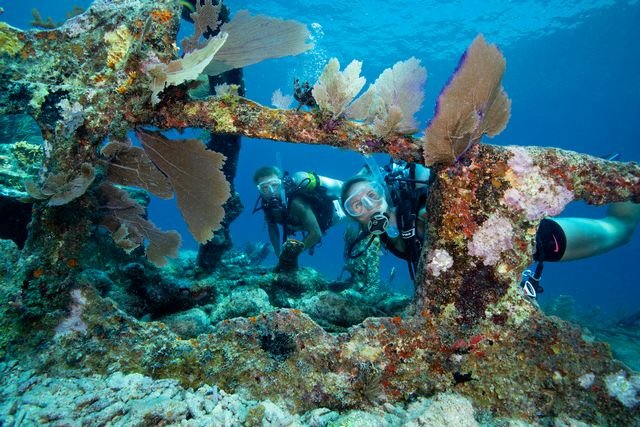
Sunken Secrets: Discover Florida Keys Shipwrecks

The National Marine Sanctuary Foundation’s Community Stewardship Coordinator, Maddie Cholnoky, explores the City of Washington shipwreck in Florida Keys National Marine Sanctuary. Photo credit: Stephen Frink
Today we’re exploring the Florida Keys Shipwreck Trail to celebrate Florida Archaeology Month. There are over 1,000 estimated shipwrecks submerged within the waters of Florida Keys National Marine Sanctuary. Fourteen of the sanctuary’s historic sites are listed in the Department of the Interior’s National Register of Historic Places. Here are some examples of notable shipwrecks and maritime mysteries found in the Florida Keys:
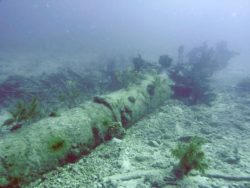
The remains of the mast of the Adelaide Baker. Photo credit: Brenda Altmeier/NOAA
Adelaide Baker: In 20 feet of water, four miles south-southeast of Duck Key, lie the remains of a three-masted iron-rigged and reinforced wooden-hull bark. The major features of this ship, locally known as the Conrad and believed to be the Adelaide Baker, are scattered over a square quarter-mile area. She signifies a period of time when the fledgling United States was growing and prospering. This was the “American Period” of shipping, in the 19th century, when the most efficient (and sometimes only) means of transporting goods was by vessel. The wreck report documents that on January 28, 1889, she was bound for Savannah, Georgia, with a load of sawn timber when she wrecked on “Coffins Patches” Reef. The irregularly shaped granite ballast concentrated along the edge of the reef marks where she was first “holed,” spilling ballast and lower cargo. The night of the shipwreck, wreckers in the area assisted the captain and crew to safety. There was no loss of life. Today, the remaining parts of the ship host a diverse overgrowth of organisms such as gorgonians, sponges, and encrusting corals.
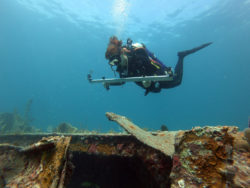
Photo credit: Brenda Altmeier
Benwood: The Benwood, was built in England in 1910, was owned by a Norwegian company and registered as a merchant marine freighter. She was 360 feet long with a 51-foot beam. On the night of April 9, 1942, the Benwood was on a routine voyage from Tampa, Florida, to Norfolk, Virginia, carrying a cargo of phosphate rock. Rumors of German U-boats in the area required her to travel completely blacked out with the Keys coastal lights three miles abeam. The ship Robert C. Tuttle, also blacked out, was traveling in the same area. The bow of the Benwood collided with the port side of the Tuttle, and its bow was crushed and taking on water. The captain gave orders to abandon ship. She lies between French Reef and Dixie Shoals on the bottom of a low profile reef and sand, in depths ranging from 25 to 45 feet. This is one of the most popular shipwreck dives in the Keys.
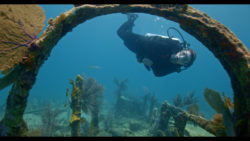
Diver on the wreck of the City of Washington. Photo credit: David Ruck
City of Washington: The Steam Ship City of Washington (SS City Washington), launched August 31, 1877, was an iron hulled steamer for use in passenger transport and the cargo trade between New York, Cuba, and Mexico. The City of Washington‘s moment in history came the night of February 15, 1898. Because of deteriorating relations between the U.S. and Spain over the rebellion in Cuba, the USS Maine was moored in Havana Harbor to protect American interests. That night the Maine exploded.
The City of Washington was moored close by and suffered damage to her awnings and deck houses by flying debris. Her crew assisted in the rescue of the Maine survivors. This was the final event leading to the Spanish-American War. During the war, the City of Washington was used as a transport ship carrying troops. On July 10, 1917, while being towed by a tug, the City of Washington ran aground and was a total loss within minutes. In 25 feet of water east of Key Largo, the remains of the City of Washington lie on Elbow Reef. The wreck site of the City of Washington is 325 feet long and contains mostly the lower bilge section of the steel hull.
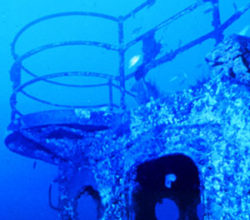
The wreck of the Duane. Photo credit: Florida Keys National Marine Sanctuary
Duane: The U.S. Coast Guard cutter lies upright on a sandy bottom in 120 feet of water one mile south of Molasses Reef off Key Largo. After being decommissioned on August 1, 1985, as the oldest active U.S. military vessel, the Duane was donated to the Keys Association of Dive Operators for use as an artificial reef. The Duane was one of seven “Treasury-Class” cutters named after prominent United States Secretaries of the Treasury: Duane, Bibb, Ingham, Hamilton, Spencer, Campbell, and Taney. Launched between 1936 and 1937, they fulfilled the varied missions of the Coast Guard during wartime and peacetime service for nearly 40 years before being retired. The fleet received distinguished commendations for action in World War II, Korea, and Vietnam. She is listed in the National Register of Historic Places.
San Pedro: a member of the 1733 Spanish treasure fleet caught by a hurricane in the Straits of Florida, sank in 18 feet of water one mile south of Indian Key. She is the oldest shipwreck on the Shipwreck Trail, with the mystique of a Spanish treasure shipwreck to draw divers and snorkelers alike. The 287-ton Dutch-built vessel San Pedro and 21 other Spanish ships under the command of Rodrigo de Torres left Havana, Cuba, on Friday, July 13, 1733, bound for Spain. The San Pedro carried 16,000 pesos in Mexican silver and numerous crates of Chinese porcelain. Upon entering the Straits of Florida, an oncoming hurricane was signaled by an abrupt wind change. The Spanish treasure fleet, caught off the Florida Keys, was ordered back to Havana by their Captain. But it was too late, the storm intensified and scattered, sank or swamped most of the fleet. In 1989, this site became a State of Florida Underwater Archaeological Preserve. Replica cannons, an anchor from another 1733 shipwreck site, and a bronze plaque were placed on the site to enhance its interpretation.
Spiegel Grove: a retired 510-foot Navy landing ship dock, is the third-largest ship ever sunk to become a new reef for divers. Sunk in May 2002, it’s positioned about 6 miles off Key Largo in 130 feet of water. With its top deck some 60 feet below the ocean surface, it remains one the Keys’ most intriguing dive sites.
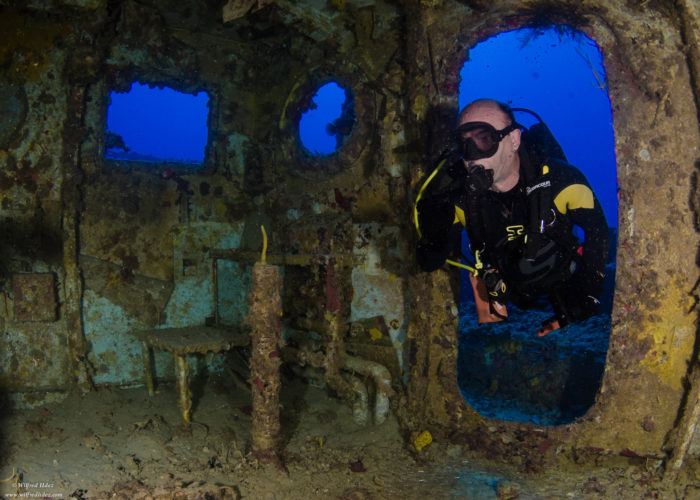
A diver peers into the wreck of the Spiegel Grove. Photo credit: Wilfred Hdez
